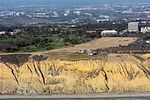2021 U.S. Open (golf)
The 2021 United States Open Championship was the 121st U.S. Open, the national open golf championship of the United States. It was a 72-hole stroke play tournament that was played June 17–20 on the South Course at Torrey Pines Golf Course in La Jolla, San Diego, California. The South Course previously hosted in 2008, which was won by Tiger Woods in a playoff. The field consisted of 156 players, with 88 gaining their place through automatic exemption criteria and the remaining 68 making it through qualifying, including two alternates. The defending champion was Bryson DeChambeau, who won the 120th U.S. Open, which had been postponed due to the COVID-19 pandemic, at Winged Foot in September 2020. Jon Rahm made a birdie on each of the final two holes to become the first U.S. Open champion from Spain and win his first major championship. Rahm finished one shot ahead of South African Louis Oosthuizen, who had held a share of the lead going into the final round. Two strokes further back in third place was American Harris English. DeChambeau had moved into the lead midway through the final round, but fell away with two bogeys, a double-bogey and a quadruple-bogey on the back-nine to finish outside the top twenty. During the tournament, Englishman Richard Bland became the oldest player to hold a share of the 36-hole lead in a U.S. Open; he finished tied for 50th place.
Excerpt from the Wikipedia article 2021 U.S. Open (golf) (License: CC BY-SA 3.0, Authors).2021 U.S. Open (golf)
North Torrey Pines Road, San Diego
Geographical coordinates (GPS) Address Nearby Places Show on map
Geographical coordinates (GPS)
| Latitude | Longitude |
|---|---|
| N 32.903888888889 ° | E -117.24611111111 ° |
Address
Torrey Pines North Course
North Torrey Pines Road
92093 San Diego
California, United States
Open on Google Maps






